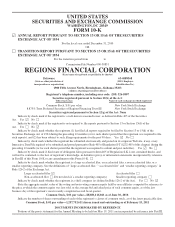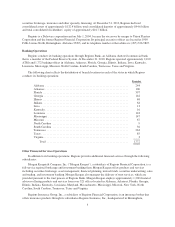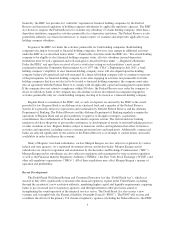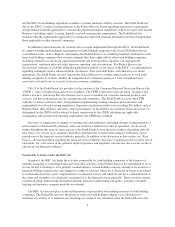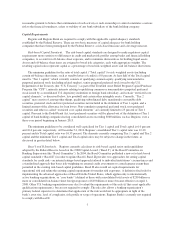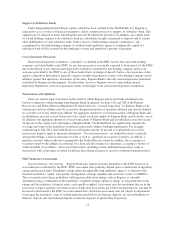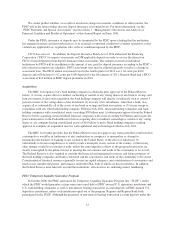Regions Bank 2010 Annual Report Download - page 19
Download and view the complete annual report
Please find page 19 of the 2010 Regions Bank annual report below. You can navigate through the pages in the report by either clicking on the pages listed below, or by using the keyword search tool below to find specific information within the annual report.Generally, the BHC Act provides for “umbrella” regulation of financial holding companies by the Federal
Reserve and functional regulation of holding company subsidiaries by applicable regulatory agencies. The BHC
Act, however, requires the Federal Reserve to examine any subsidiary of a bank holding company, other than a
depository institution, engaged in activities permissible for a depository institution. The Federal Reserve is also
granted the authority, in certain circumstances, to require reports of, examine and adopt rules applicable to any
holding company subsidiary.
In general, the BHC Act limits the activities permissible for bank holding companies. Bank holding
companies electing to be treated as financial holding companies, however, may engage in additional activities
under the BHC Act as described below under “—Permissible Activities under the BHC Act.” For a bank holding
company to be eligible to elect financial holding company status, all of its subsidiary insured depository
institutions must be well-capitalized and well-managed as described below under “—Regulatory Remedies
Under the FDIA” and must have received at least a satisfactory rating on such institution’s most recent
examination under the Community Reinvestment Act of 1977 (the “CRA”). Beginning in July 2011, a bank
holding company’s eligibility to elect financial holding company status will also depend upon the holding
company being well-capitalized and well-managed. If a financial holding company fails to continue to meet any
of the prerequisites for financial holding company status after engaging in activities not permissible for bank
holding companies that have not elected to be treated as financial holding companies, the company must enter
into an agreement with the Federal Reserve to comply with all applicable capital and management requirements.
If the company does not return to compliance within 180 days, the Federal Reserve may order the company to
divest its subsidiary banks or the company may discontinue or divest investments in companies engaged in
activities permissible only for a bank holding company electing to be treated as a financial holding company.
Regions Bank is a member of the FDIC, and, as such, its deposits are insured by the FDIC to the extent
provided by law. Regions Bank is an Alabama state-chartered bank and a member of the Federal Reserve
System. It is generally subject to supervision and examination by both the Federal Reserve and the Alabama
Department of Banking. The Federal Reserve and the Alabama Department of Banking regularly examine the
operations of Regions Bank and are given authority to approve or disapprove mergers, acquisitions,
consolidations, the establishment of branches and similar corporate actions. The federal and state banking
regulators also have the power to prevent the continuance or development of unsafe or unsound banking practices
or other violations of law. Regions Bank is subject to numerous statutes and regulations that affect its business
activities and operations, including various consumer protection laws and regulations. Additionally, commercial
banks are affected significantly by the actions of the Federal Reserve as it attempts to control money and credit
availability in order to influence the economy.
Many of Regions’ non-bank subsidiaries, such as Morgan Keegan, are also subject to regulation by various
federal and state agencies. As a registered investment adviser and broker-dealer, Morgan Keegan and its
subsidiaries are subject to regulation and examination by the Securities and Exchange Commissioner (“SEC”).
Morgan Keegan and its subsidiaries are also subject to regulation and examination by state securities regulators
as well as the Financial Industry Regulatory Authority (“FINRA”), the New York Stock Exchange (“NYSE”) and
other self-regulatory organizations (“SROs”). All of these regulations may affect Morgan Keegan’s manner of
operation and profitability.
Recent Developments
The Dodd-Frank Wall Street Reform and Consumer Protection Act (the “Dodd-Frank Act”), which was
enacted in July 2010, significantly restructures the financial regulatory regime in the United States, including
through the creation of a new resolution authority, mandating higher capital and liquidity requirements, requiring
banks to pay increased fees to regulatory agencies, and through numerous other provisions aimed at
strengthening the sound operation of the financial services sector. The Dodd-Frank Act also creates a new
systemic risk oversight body, the Financial Stability Oversight Council (“FSOC”). The FSOC will oversee and
coordinate the efforts of the primary U.S. financial regulatory agencies (including the Federal Reserve, the FDIC
5




